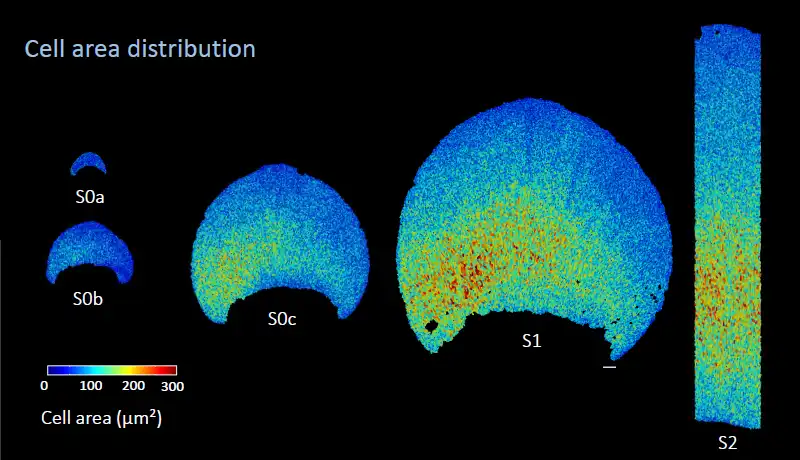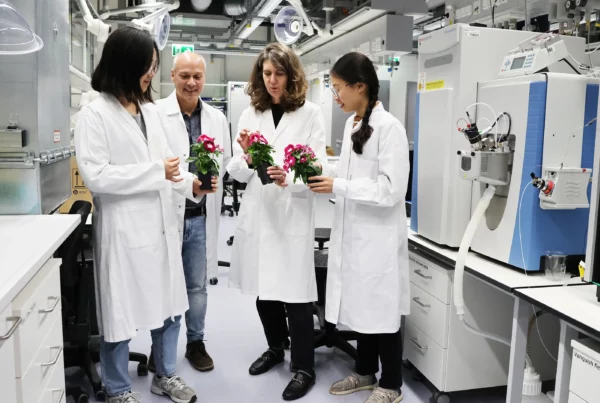Flowers like hibiscus use an invisible blueprint established very early in petal formation that dictates the size of their bullseyes – a crucial pre-pattern that can significantly impact their ability to attract pollinating bees.
The study, by researchers at the University of Cambridge’s Sainsbury Laboratory also found that bees prefer larger bullseyes over smaller ones and fly 25% faster between artificial flower discs with larger bullseyes – potentially boosting efficiency for both bees and blossoms.
Patterns on the flowers of plants guide insects, like bees, to the centre of the flower, where nectar and pollen await, enhancing the plant’s chances of successful pollination. Despite their importance, surprisingly little is known about how these petal patterns form and how they have evolved into the vast diversity we see today, including spots, stripes, veins, and bullseyes.
In research published in Science Advances, Cambridge scientists combined developmental biology, evolutionary biology and computational modelling to shed light on this mystery.
Using a small hibiscus plant as a model, researchers compared closely related plants with the same flower size but three differently sized bullseye patterns featuring a dark purple centre surrounded by white – H. richardsonii (small bullseye covering 4% of the flower disc), H. trionum (medium bullseye covering 16%) and a transgenic line (mutation) of H. trionum (large bullseye covering 36%).
They found that a pre-pattern is set up on the petal surface very early in the flower’s formation long before the petal shows any visible colour. The petal acts like a ‘paint-by-numbers’ canvas, where different regions are predetermined to develop specific colours and textures long before they start looking different from one another.
The research also shows plants can precisely control and modify the shape and size of these patterns using multiple mechanisms, with possible implications for plant evolution. By fine-tuning these designs, plants may gain a competitive advantage in the contest to attract pollinators or maybe start attracting different species of insects.
Dr Edwige Moyroud, who leads a research team studying the mechanisms underlying pattern formation in petals, explained: “If a trait can be produced by different methods, it gives evolution more options to modify it and create diversity, similar to an artist with a large palette or a builder with an extensive set of tools. By studying how bullseye patterns change, what we are really trying to understand is how nature generates biodiversity.”
Bullseye pattern provides a target for bees
The primary function of petals is to attract pollinators. While their beauty may captivate us, flowers are primarily reproductive structures that have developed all sorts of tricks to maximise the chance of producing seeds.
Many flowers use colourful motifs on their petals to capture the attention of pollinators and enhance pollen transfer and thus fertilisation.
A bullseye is a target-like motif often found in flowers. This pattern typically consists of contrasting colors, with a central spot surrounded by one or more rings of different shades.
The bullseye pattern is thought to guide pollinators, such as bees, toward the center of the flower where the nectar and pollen are located, enhancing the plant’s chances of successful pollination. Some bullseye patterns are visible only under UV light, which many pollinators can see, making them invisible to us but very effective at attracting insects.
In the small hibiscus Venice Mallow (Hibiscus trionum), a striking bullseye pattern is formed on the upper surface (adaxial side) of the petals, creating an inner circle of dark purple and outer circle of white on each flower.
The surface texture of the petals also varies between the differently coloured sections of the petal. The cells on the purple pigmented section have cuticular striation patterns that reflect UV light, while the outer white surrounds of the petals have conical-shaped cells, which create a textured surface and provide better grip for bees landing on petals.
How do plants make precise petal patterns to attract pollinators?
But how is the plant controlling the development of this distinctive and consistent bullseye petal pattern? How do individual epidermal cells and their neighbours know what pigment and texture to produce?
Previous research has identified specific transcription factors and enzymes responsible for producing the petal pigments and surface textures, but the upstream processes that divide the petal epidermis into two distinct regions were a mystery.
Lead author Dr Lucie Riglet investigated the mechanism behind hibiscus petal patterning by analysing petal development in the three hibiscus flowers that had different bullseye sizes.
Studying petals is challenging because their patterns often form on the top surface, which is hard to observe during early development when the petal is still wrapped inside the flower bud.
To tackle this challenge, Dr Riglet created a process to carefully dissect, prepare, and image tiny hibiscus petals under a microscope.
Dr Riglet said: “We wanted to know if there was any visible difference between cells early in petal development that might indicate where the petal pattern was forming. At the earliest stage we could dissect, the petals have around 700 cells and are still greenish in colour, with no visible purple pigment and no difference in cell shape or size. When the petal further develops to 4000 cells, it still does not have any visible pigment, but we identified a specific region where the cells were larger than their surrounding neighbours. This is the pre-pattern!”
She found that the pre-pattern begins as a small, crescent-shaped region long before the bullseye is visible on tiny petals less than 0.2mm in size.
The shape of the pattern forming on the early-stage petals was not what the researchers were expecting to see. Dr Riglet explained: “Because the mature petal has elongated cells at the base and conical shaped cells at the top, at first, we were expecting to see a linear gradient pattern of cell differentiation spreading from the base to the tip of the petals, but instead we observed a crescent shape developing from one side of the petal that then expands and spreads from left to right as the petal matures.”
Starting out as a lopsided croissant, the asymmetrical pattern then expands to form a crescent-shaped boundary separating the two regions of the petal long before any bullseye pattern becomes visible.
Dr Moyroud added: ‘”Lucie’s finding is important because it tells us that flowers are shy early-planners and if we want to understand how they fabricate patterns we need to study very early stages of flower development, where nothing obvious seems to happen, instead of the later stages where the bullseye becomes visible to the naked eye.”
Early planning challenges
While early planning may seem like a good idea, it also creates a challenge. How does the plant maintain the pattern proportions when the petal size still has a lot more growing to do and will experience a 100-fold increase to reach its final size?
Computational scientist at SLCU, Dr Argyris Zardilis developed a computational model to try and find answers to this conundrum. Dr Zardilis said: “Mathematical models can help us to test our hypotheses about how cells grow together to form complex shapes and patterns. Using a one-dimensional computational simulation, we showed how differential cell expansion and division are valid mechanisms to maintain or modify the bullseye proportions.”
Combining both computational models and experimental results, the researchers showed that plants can vary bullseye dimensions very early during the pre-patterning phase or modulate growth in either region of the bullseye, by adjusting cell expansion or division, later in development.
Pattern dimensions really do matter to pollinators
Dr Riglet then compared the relative success of the bullseye patterns in attracting pollinators using artificial flower discs that mimicked the three different bullseye dimensions. Dr Riglet explained, “We used 3D-printed discs mimicking the color patterns of the three hibiscus flowers to see if pollinators could tell the difference between bullseyes of various sizes and whether they had a preference. The bees favored the medium-sized and larger bullseyes over the smallest bullseye, but they appear to equally like medium and large sizes.
“We then tested to see if this preference translated into foraging efficiency. The bees not only preferred the medium and larger bullseyes, they were also 25% quicker visiting the flowers. Foraging requires a lot of energy and so if a bee can visit 4 flowers rather than 3 flowers in the same time, then this is beneficial for the bee, and also the plant.”
Dr Moyroud added: “This research highlights the remarkable precision with which plants can craft colorful patterns, fine-tuning cell proliferation and differentiation to produce visual cues and communicate effectively with insect pollinators. This discovery not only advances our understanding of plant biology but also underscores the intricate connections between plants and their environments.
“The research illuminates that pre-patterning of petals occurs very early in their development and also suggests these pre-patterning strategies could have early evolutionary origins. Living organisms like plants often re-use genetic mechanisms and so it is possible that the patterning processes that produce bullseye flowers are also used to control the patterning of all sorts of different flowers or even to pattern in other plant organs like leaves, but this needs further research.
“Our next step is to look for what is responsible for generating the petal pre-patterning. We expect that there is an external signal involved and that the cells located closest to the source of the signal are those that we first see the bullseye boundary arising from.”
These findings pave the way for further research into how petal patterns influence the survival and evolution of flowering plant species.
For example, H. richardsonii, which has the smallest bullseye of the three hibiscus plants studied in this research, is a critically endangered plant native to New Zealand. H. trionum is also found in New Zealand, but not considered to be native, and is widely distributed across Australia and Europe and has become a weedy naturalised plant in North America. Additional research is needed to determine whether the larger bullseye size helps H. trionum attract more pollinators and enhance its reproductive success.
In summary the research findings reveal that:
- Pre-patterning of petal epidermis: The boundary separating different regions of the petal pattern is established long before the pattern becomes visible, suggesting that the petal epidermis is pre-patterned.
- Mechanisms of pattern variation: Plants employ at least two mechanisms to create variations in petal pattern proportions. They can either control where the pattern boundary is initially specified during the pre-patterning phase or adjust growth on either side of the boundary during later developmental stages.
- Natural diversity in petal pattern dimensions: Variations in petal pattern dimensions among H. trionum and its relatives contribute to natural diversity and are biologically significant. These variations likely impact reproductive isolation and speciation, as pollinators like buff-tailed bumblebees can identify food sources based solely on bullseye dimensions and show innate preferences for specific pattern proportions.
Read the paper: Science Advances
Article source: University of Cambridge
Image: A crescent-shaped petal pre-pattern was observed very early in petal development before any visible pigment. Colour map of cell area across the adaxial epidermis of HtTCP4.1 OE petals during early developmental stages (from S0a to S2E). Scale bar, 100 μm. Credit: Science Advances






